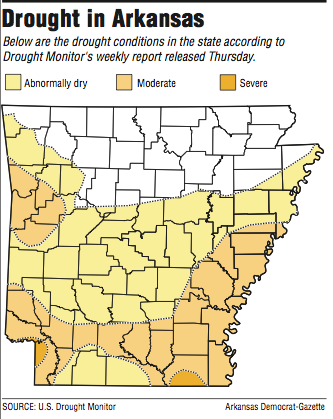Nearly 70 percent of Arkansas is in some form of drought, including two areas of the state that haven't seen such dry conditions in a year.
A three-month forecast released last week by the National Oceanic and Atmospheric Administration calls for a drier and warmer winter for the state this year, meaning the drought is expected to worsen into the spring.
"It's dry," Ashley County Judge David Holland said. "It's nothing but powdered dust.
"I'm really frightened. You get a wind rolling and fire conditions will be bad."
The southern half of Ashley County is considered to be in a "severe drought," according to the National Drought Mitigation Center, meaning the area's rainfall for the past 30 days was 3 to 4 inches below normal.
Holland has issued a burn ban for his county, joining Bradley, Chicot, Hempstead and Jefferson counties in prohibiting the burning of trash and debris.
The drought center, based at the University of Nebraska-Lincoln, also said the northeastern quarter of Miller County is in a severe drought. The center releases a weekly report on drought conditions across the U.S.
It's the first time anywhere in Arkansas has been rated as being in a "severe drought" since Oct. 23, 2015, according to the center.
Much of southern Arkansas was classified as being in "moderate drought," meaning the area is 2-3 inches short of average rainfall over a 30-day period, and a swath in central Arkansas was rated as "abnormally dry," meaning the area was 1 to 2 inches below average rainfall for the past 30 days.
"Usually, droughts manifest themselves quickly in warmer months," said David Simeral, an associate research meteorologist with the Western Regional Climate Center in Reno, Nev.
Simeral authored this week's drought report, which was released Thursday.
"Evaporation rates are much higher when it's warmer," Simeral said. "It is possible to see drought occur at this time of year, but it's rare and unique."
Arkansas received heavy rains in August, which kept drought conditions at a minimum. But September and October were drastically drier, the National Weather Service reported.
In September, Texarkana recorded only half an inch of rain for the month. Normally, the Miller County town measures an average of 3.43 inches of rain during the month. Little Rock saw 1.31 inches of rain for the month, down from its average of 3.18 inches in September.
"Stream flows are at some of the lowest percentages we've seen, meaning the drought can quickly worsen because there is no available moisture," Simeral said.
"We're starting to see some agricultural impacts on the areas."
All of Mississippi is considered in some form of drought, as is Louisiana, where three weeks ago only 42 percent of the state was in some state of drought.
Kevin Norton, an agent with the University of Arkansas' Division of Agriculture in Ashley County, said farmers have had to use stored hay to feed cattle.
Farmers were able to grow plenty of hay earlier this year because of plentiful rainfall but are concerned that if the drought continues, they may have to begin irrigating wheat and oat crops, Norton said.
"We can't do it without some moisture," he said. "We've lost a few trees because of the dryness and it's going to keep making things worse."
The National Oceanic and Atmospheric Administration's three-month winter outlook for December through February doesn't bode well for Arkansas. The outlook calls for warmer-than-average temperatures and below-average precipitation.
A mild winter is forecast for much of the southern half of the United States, according to the administration. Only the north-central U.S. -- primarily Minnesota, the upper peninsula of Michigan, Montana, North Dakota, South Dakota and Wisconsin -- are forecast to see below-average temperatures this winter.
In Ashley County, the dry conditions mean Halloween revelers can't light bonfires to celebrate the holiday Monday evening, Holland said.
"We've had police stop people from grilling because of the dry conditions," the judge said. "We're going to have deer hunters coming in here for five days. We can't let them burn."
He said the county has seen several small wildfires in the past few weeks.
The Arkansas Forestry Commission said the southern third of the state and 13 counties in Northwest Arkansas are considered to be in "moderate" danger for wildfire. People are asked to burn debris and trash in the early morning or late evening hours when winds are down and humidity levels are higher to avoid the potential for out-of-control fires.
The state should see dry conditions for another week, said National Weather Service meteorologist Charles Dalton of North Little Rock.
A ridge of high pressure that is sitting over the state and keeping rain-producing systems away won't break down until late next week, he said. There is a slight change for widespread rain Thursday, Dalton said.
"Generally speaking, the weather pattern is usually more active now," he said. "For the drought to be increasing this time of year is abnormal."
State Desk on 10/28/2016
